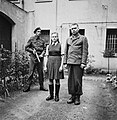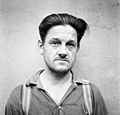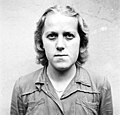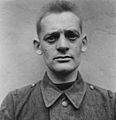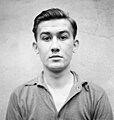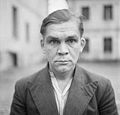Bergen-Belsen trial
The first Bergen-Belsen Trial ( English: Belsen Trial - Trial against Josef Kramer and 44 others ) against German war criminals took place in September 1945 , which was held by a British military tribunal from September 17 to November 17, 1945 in the gymnasium Lindenstrasse 30 was carried out in Lüneburg . The accused were members of the SS and some Kapos from the Bergen-Belsen concentration camp , who were arrested by the British army after the camp was surrendered in mid-April 1945. Before the arrest, three SS men were shot while trying to escape and one committed suicide . Of the approximately 77 members of the camp staff arrested, 17 died of typhus by June 1, 1945 .
In contrast to two other Bergen-Belsen trials, this first war criminal trial on German soil also met with great international interest and was followed by around 200 journalists and trial observers. In this process, acts were also negotiated that the accused had previously committed in the Auschwitz-Birkenau concentration camp , and a broader public learned about selections , gas chambers and crematoria .
accusation
48 members of the former camp administration were charged with war crimes . Three accused SS men left before the trial due to illness (Nikolas Jenner, Paul Steinmetz and Walter Melcher). The remaining 45 defendants were divided into 17 male members of the SS, 16 female SS guards and 11 prison functionaries . Eleven of the SS guards had only been active since 1944 and had previously been recruited for Auschwitz satellite camps by industrial companies . Most of the accused had only arrived in Bergen-Belsen from February 1945, some of them only arrived there two days before the liberation.
accused
The defendants in the trial included:
- Josef Kramer , camp commandant at Bergen-Belsen concentration camp, previously camp commandant at Auschwitz-Birkenau concentration camp,
- Fritz Klein , camp doctor in the Bergen-Belsen concentration camp, who actively participated in selections and deportations ,
- Franz Hößler , deputy camp commandant in the Bergen-Belsen concentration camp, previously protective custody camp leader in the Auschwitz-Birkenau concentration camp and the Dora-Mittelbau concentration camp ,
- Johanna Bormann , concentration camp guard in Bergen-Belsen and Auschwitz, member of the SS retinue ,
- Elisabeth Volkenrath , previously supervisor at Auschwitz concentration camp ,
- Irma Grese , most recently labor service leader in the Bergen-Belsen concentration camp,
- Stanisława Starostka , inmate who rose to become an assistant in the camp administration, feared by the inmates as "Stana the flogger",
- Erich Zoddel , camp elder.
- Hertha Bothe , after various short-term jobs as a supervisor, she headed the forest command
- Peter Weingartner , acted as block leader in the women's camp
- Hilde Lohbauer , was part of the labor service and supervised work details
- Ansgar Pichen , head of the camp kitchen
- Helena Kopper , prisoner functionary
- Franz Starkfl , led the death march in April 1945 from the Kleinbodungen satellite camp to the Bergen-Belsen concentration camp
- Wilhelm Dörr , deputy of Franz Stark
- Oskar Schmitz
- Ignatz Schlomowicz , prisoner functionary
- Karl Francioh , charged with his crimes committed in Bergen-Belsen
- Hertha Ehlert , for assisted manslaughter
Legal bases
The legal basis for the indictment of all Bergen-Belsen trials was the “ Regulations for the Trial of War Criminals made under Royal Warrant” of June 14, 1945 for British military courts. The international law already in force at the time of the offense was used, so that the legal principle “ nullum crimen, nulla poena sine lege ” was not violated. The jurisprudence valid before the International Military Tribunal in the Nuremberg Trials , in particular the offense of crimes against humanity , did not yet play a role here.
The two main charges concerned war crimes in violation of the laws and customs of war and ill-treatment that resulted in the deaths of Allied nationals. A distinction was made between individually verifiable brutal assaults or murder on the one hand and general participation in the murderous concentration camp system on the other. Members of the SS and the camp guards were charged with a joint conspiracy (" conspiracy "), which imputed the accused to approvingly participate in a system of killings, atrocities and inhuman neglect and implied a presumption of guilt . However, none of the accused was convicted for “conspiracy” alone.
Process execution
Various reports - also from the British side - of the brutal treatment of the SS members who were waiting for their trial in Celle prison.
The process flow was as follows:
- 1. Examination of witnesses by the prosecution
- 2. Reading of the written testimony
- 3. Hearing of the experts and witnesses of the defense
- 4. Hearing of the accused
- 5. Prosecution and defense closing arguments
- 6. Announcement of the judgments
In addition, at the request of the prosecution, the film made by British soldiers about the liberation of the Bergen-Belsen concentration camp was shown on September 20, 1945, which illustrates the catastrophic conditions and the mass graves in the camp.
The hasty preparation of the indictment proved to be inadequate and questionable. None of the SS men who fled on April 13th were searched, caught or charged, although prisoners immediately put together a list of names. After the prosecution initially considered collective responsibility and complicity as sufficient grounds for punishment, they then tried to prove individual crimes for the individual accused. As evidence, "affidavits" were often presented by prisoners who were no longer available as witnesses; other witnesses cross-examined themselves into contradictions or were unable to identify the alleged perpetrator. The prisoner Oskar Schmitz was falsely accused of being an SS man and had no opportunity to clear up this error until the trial began.
Since the language of the court was English, interpreters had to translate into English, German and Polish between the court and the defendants. As a result, the process duration originally set for two to four weeks has been extended considerably. Major General Berney-Ficklin took over the presidency of the military tribunal and, like his associate judges - except for a civil legal advisory board - wore a uniform during the trial. The prosecution consisted of four British officers. In contrast to the 40 German defendants, the five Polish defendants were represented by Polish defense lawyers.
British officers - without exception lawyers - were assigned to the German defendants as official defenders, who criticized inconsistencies in the time and place of information, inaccuracies and discrepancies. Some defense lawyers were described as sympathizers of the fascist “ British Union ” by Sir Oswald Mosley because they used anti-Semitic stereotypes: “Remember,” one of the defense lawyers addressed the judge, “that these people are dealing with the dregs of the ghettos from the East -Europe had to do. ”First of all, one has to deal with the scrap of the SS, replied the acting judge.
Defense lawyers asserted that the detention of the accused was not legal: in the "armistice agreement" for the surrender without a fight, a free withdrawal was agreed. However, the corresponding wording was only unambiguous for members of the Wehrmacht. In addition - so the prosecutors argued - the agreement was violated by the destruction of the camp registry and the use of firearms on April 15th. The historian Eberhard Kolb argued in retrospect: "It should have appeared as a unique mockery of the suffering and dying of the tens of thousands if the English [...] had let the SS command staff leave unmolested ..."
The judges are certified to conduct an objective negotiation. Their careful gathering of evidence largely made up for the inadequate preparation of the trial.
All of the defendants pleaded "not guilty".
Judgment and ratings
The verdicts were pronounced on November 17, 1945. As a result, 11 defendants were sentenced to death by hanging who had been convicted of grievous bodily harm to prisoners. The judgments were carried out on December 13, 1945 by Albert Pierrepoint in Hameln . The execution was carried out using a gallows with two trap doors. Two convicts were always hanged at the same time, only the three women were executed individually. In addition, life and 18-term prison sentences were imposed. 15 defendants were acquitted.
Almost all prison terms were reduced by a third in the years that followed for good behavior or pardons.
Irma Grese wrote five days before her execution: "But you will not have the triumph that I humiliate myself even a finger's breadth. [...] Because I fulfilled my duty for my fatherland." Such a "suggestion of righteousness" became apparent also in the defense strategies of others: the unwillingness to take up work, one's own insignificant position, the inevitable “order from above” and “only his duty” or the alleged effort to lessen the harassment of others. Jörg Friedrich wrote: “In the Lüneburg gymnasium, the pattern of the Nazi trial was already emerging, an event to which more or less small people are dragged who have meanwhile quickly turned into victims: victims of the times, victims of their commanders and as everyone can see, victims of their far too overwhelmed morals. "
Eberhard Kolb evaluates the process as fair despite some of the shortcomings he also pointed out: “You have to put yourself back in the atmosphere of 1945 and the angry public opinion of the victorious states, which demanded a summary process and categorical convictions in order to be able to fully appreciate what exemplary procedural fairness the Belsen process was carried out; The long duration of the trial alone - repeatedly heavily criticized in the Allied countries - and the judgments made at the end of the trial - in some cases also sharply criticized in the Allied countries - are proof that the verdict was not given before the trial began it was established and that the evidence was not a mere farce. "
The 45 judgments in detail
| Defendant | function | rank | Charges: Belsen (B) - Auschwitz (A) | judgment |
|---|---|---|---|---|
| Josef Kramer | Camp commandant | SS-Hauptsturmführer | A + B | Death sentence, executed |
| Franz Hoessler | deputy camp commandant | SS-Obersturmführer | A + B | Death sentence, executed |
| Fritz Klein | Camp doctor | SS-Hauptsturmführer | A + B | Death sentence, executed |
| Peter Weingartner | Block leader | SS-Hauptscharführer | A + B | Death sentence, executed |
| Karl Francioh | Head of the camp kitchen | SS Rottenführer | B. | Death sentence, executed |
| Ansgar Pichen | Managerial function warehouse kitchen | SS man | B. | Death sentence, executed |
| Franz Starkfl | unknown | SS-Hauptscharführer | B. | Death sentence, executed |
| Wilhelm Dörr | unknown | SS-Oberscharführer | B. | Death sentence, executed |
| Irma Grese | Labor service leader and report leader | SS superintendent | A + B | Death sentence, executed |
| Elisabeth Volkenrath | Superintendent | SS superintendent | A + B | Death sentence, executed |
| Johanna Bormann | Pigsty work detail | SS overseer | A + B | Death sentence, executed |
| Erich Zoddel | Function prisoner | Camp elder | B. | Life sentence, sentenced in another trial in August 1945 by a military tribunal and executed |
| Wladislaw Ostrowski | Function prisoner | Kapo | B. | 15 years imprisonment - released in 1955 |
| Helena Kopper | Function prisoner | Block elder | B. | 15 years imprisonment - released in 1952 |
| Otto Kulessa | Block leader | SS squad leader | B. | 15 years imprisonment - released in 1955 |
| Heinrich Schreirer | Block Leader Political Department | SS-Oberscharführer | A + B | 15 years imprisonment - released in 1950 |
| Hertha Ehlert | Prisoner clothing store - deputy supervisor | SS overseer | A + B | 15 years imprisonment - released in 1953 |
| Hilde Lohbauer | Function prisoner | Kapo | A + B | 10 years imprisonment - released in 1950 |
| Antoni Aurdzig | Function prisoner | Block elder | B. | 10 years imprisonment - released in 1952 |
| Johanne Roth | Function prisoner | Kapo room elder | B. | 10 years imprisonment - released in 1950 |
| Stanislawa Staroska | Function prisoner | Kapo | A. | 10 years imprisonment - suicide in prison 1946 |
| Ilse Forster | Kitchen staff | SS overseer | B. | 10 years imprisonment - released in 1951 |
| Hertha Bothe | Forest command | SS overseer | B. | 10 years imprisonment - released in 1951 |
| Irene Haschke | Kitchen staff | SS overseer | B. | 10 years imprisonment - released in 1951 |
| Gertrud Sauer | different activities | SS overseer | B. | 10 years imprisonment - released in 1951 |
| Anna Hempel | Kitchen staff | SS overseer | B. | 10 years imprisonment - released in 1951 |
| Gertrud Fiest | Overseer in the women's camp (section 2) | SS overseer | B. | Five years imprisonment - released in 1949 |
| Medislaw Burgraf | Function prisoner | Block elder room service | B. | Five years imprisonment - released in 1949 |
| Frieda Walter | Kitchen staff | SS overseer | B. | 3 years imprisonment - released in 1948 |
| Hilda Lisiewitz | different tasks | SS overseer | B. | 1 year imprisonment - released in 1946 |
| Georg Kraft | Camp leader and cook | SS-Unterscharführer | A + B | acquittal |
| Josef Klippel | Managerial function warehouse kitchen | SS-Sturmbannführer | B. | acquittal |
| Fritz Mathes | Kitchen staff | SS-Hauptscharführer | B. | acquittal |
| Karl Egersdörfer | Grocery store | SS-Unterscharführer | B. | acquittal |
| Use Lothe | Function prisoner | Kapo | B. | acquittal |
| Oskar Schmitz | Function prisoner | Oldest camp 2 | B. | acquittal |
| Ignatz Schlomowicz | Function prisoner | Block elder | B. | acquittal |
| Anton Polanski | Function prisoner | Inmate doctor | B. | acquittal |
| Walter Otto | Warehouse electrician | SS-Oberscharführer | B. | acquittal |
| Erich Persch | Medical grade | SS-Unterscharführer | B. | acquittal |
| Ida Forster | Kitchen staff | SS overseer | B. | acquittal |
| Klara Opitz | Kitchen staff | SS overseer | B. | acquittal |
| Charlotte Klein | u. a. Kitchen staff | SS overseer | B. | acquittal |
| Hildegard Hahnel | different activities | SS overseer | B. | acquittal |
| Ladislaw Gura | SS Rottenführer under arrest | Kapo | B. | Acquittal - sick during the process |
The second Bergen-Belsen trial
A second "Bergen-Belsen trial" was held before a British military court from May 16 to 30, 1946 in Celle against nine people. This successor trial, which was barely noticed by the German public, differed from the other war crimes trials carried out by the British military judiciary, as the individual defendants were tried one after the other, so that the trials usually only lasted a day or two. Major Glendinning took over the chairmanship of the military tribunal, to which three British military officers (Major Tabaschnik, Major Clarke, Captain Baker) and the Polish Lieutenant Szwedzicki were assigned.
This trial was originally planned for 22 suspects who had not been in British custody the previous year or who were unable to stand trial due to illness. Since most serious crimes were committed in other zones of occupation and should better be tried there, only ten people were charged in the end, one of whom dropped out because of mistaken identity. There were also SS men on trial who had only stayed in Bergen-Belsen for a few days, as they had come to the camp as transport leaders with "evacuation trains" from satellite camps of Neuengamme .
Four of the defendants were sentenced to death and five were sentenced to early prison terms. Among the defendants sentenced to death was Walter Quakernack , who had been involved in the first gassing of Soviet prisoners of war in Auschwitz in 1941. Karl Heinrich Reddehase , who ran the Hambühren-Waldeslust subcamp , was also sentenced to death . Almost the entire population of his home village stood up for block leader Heinz Heidemann with a petition for clemency . The Polish Kapo Kasimir Cegielski was not caught until 1946 in Amsterdam. Because of the mistreatment of prisoners, sometimes resulting in death, he was retried before a British military court in Lüneburg. After a five-day trial, he was sentenced to death on June 18, 1946.
The death sentences were carried out on October 11, 1946 in the prison in Hameln by hanging. As in the first Bergen-Belsen trial, the executioner of England, Albert Pierrepoint, carried out the executions. The imposed time penalties were later reduced by half or even two thirds.
The nine judgments in detail
| Defendant | function | rank | judgment |
|---|---|---|---|
| Heinz Lüder Heidemann | Block leader | SS Rottenführer | Death sentence, executed |
| Walter Quakernack | Head of the Hanover-Linden subcamp | SS-Oberscharführer | Death sentence, executed |
| Karl Heinrich Reddehase | Block leader | SS Sturmscharführer | Death sentence, executed |
| Kasimir Cegielski | Kapo | Function prisoner | Death sentence, executed |
| Theodor Wagner | SS-Oberscharführer | 20 years imprisonment, released in 1954 | |
| Karl Schmitt | Block leader | SS Rottenführer | 15 years imprisonment, released in 1951 |
| Gertrud Heise | SS superintendent | 15 years imprisonment, after revision in August 1946: seven years imprisonment | |
| Martha Linke | SS overseer | 12 years imprisonment, after revision in August 1946: seven years imprisonment | |
| Anneliese Kohlmann | Overseer in Neuengamme concentration camp | SS overseer | 2 years imprisonment - released in 1946 |
The third Bergen-Belsen trial
A third "Bergen-Belsen Trial" took place from April 14 to 16, 1948 in the Hamburg Curiohaus ; it is therefore also carried out as one of the Curiohaus processes . The only accused was the commander of the guard company in Bergen-Belsen, Julius Kurt Meyer. In contrast to the previous proceedings, a civil German lawyer was admitted to the defense.
Meyer was accused of participating in the abuse of Allied prisoners and of having been involved in the death of a Polish woman. Meyer denied this accusation on the correct grounds that as the leader of the guard company he had no free access within the camp. Although the testimony did not match and the defense pointed to a possible mix-up, Meyer was sentenced to life imprisonment.
In this trial, too, numerous people stood up for the accused SS man, who was “a nice person” and “already against Hitler ” before the war . - Meyer was released from prison in December 1954.
Follow-up processes
Following the pattern of this trial, the British carried out a total of 314 trials against 989 German nationals who had participated in war crimes between 1939 and 1945. 43 other lawsuits concerned Italian and Austrian nationals. They negotiated crimes against Allied civilians and Allied military personnel, including concentration camp prisoners. They therefore often concerned camp personnel in larger and smaller NS labor and extermination camps. Crimes against civilians who had been abducted as slave labor or murdered in retaliation for partisan actions were also included.
The last British trial against a Nazi criminal was against Field Marshal Erich von Manstein and lasted from August 23 to December 19, 1949.
literature
- John Cramer: Belsen Trial 1945 . Wallstein, Göttingen 2011, ISBN 978-3-8353-0900-5 .
- Claudia Taake: Accused. SS women in court . Library and information system of the Univ. Oldenburg, 1998, ISBN 3-8142-0640-1 .
- Alexandra-Eileen Wenck: Crimes as “fulfillment of duty”? The prosecution of Nazi violent crimes using the example of the Bergen-Belsen concentration camp. In: Neuengamme Concentration Camp Memorial (Ed.), Arr. v. Kurt Buck: The early post-war trials. Contributions to the History of National Socialist Persecution in Northern Germany Vol. 3, Ed. Temmen, Bremen 1997, p. 38ff. ISBN 3-86108-322-1 .
- United Nations War Crimes Commission (Ed.): Law reports of trials of war criminals, selected and prepared by the United Nations War Crimes Commission. 3 volumes. William S. Hein Publishing, Buffalo NY 1997, ISBN 1-57588-403-8 , (reprint of the original edition from 1947-1949). Available as PDF
Web links
- First Bergen-Belsen Trial: Defendants and Judgments
- Mazal: First Belsen Trial: Protocols (English)
- Second Bergen-Belsen Trial
- Photos and features of the defendants
Individual evidence
- ↑ Claudia Taake: Accused: SS women in court. P. 112 f.
- ^ 1st Belsen Trial Transcripts: Indictment. Retrieved July 11, 2020 .
- ↑ Alexandra-Eileen Wenck: Crimes as 'fulfillment of duty'? The prosecution of Nazi violent crimes using the example of the Bergen-Belsen concentration camp. In: Neuengamme Concentration Camp Memorial (ed.): The early post-war processes. Bremen 1997, ISBN 3-86108-322-1 , p. 40.
- ↑ Alexandra-Eileen Wenck: crime ... p. 40.
- ↑ Alexandra-Eileen Wenck: crime ... p. 41.
- ↑ Alexandra-Eileen Wenck: crime ... p. 42.
- ^ A b Claudia Taake: Accused: SS women in court. P. 52 f.
- ↑ Eberhard Kolb: Bergen-Belsen. From 'residence camp' to concentration camp 1943–1945. 5th adult and revised Aufl. Göttingen 1996, p. 58f / Alexandra-Eileen Wenck: Verbrechen ... p. 42f
- ↑ Jörg Friedrich: The cold amnesty. Frankfurt / M. 1984, ISBN 3-596-24308-4 , p. 123 / Alexandra-Eileen Wenck: Verbrechen ... p. 42 with note 32.
- ↑ Eberhard Kolb: Bergen-Belsen ... p. 54.
- ↑ Reinhard Kolb: Bergen-Belsen ... , p. 59.
- ↑ Claudia Taake: Accused: SS women in court. P. 54.
- ↑ a b Alexandra-Eileen Wenck: crime ... p. 43.
- ↑ quoted from Alexandra-Eileen Wenck: Verbrechen ... p. 38.
- ↑ Jörg Friedrich: The cold amnesty. P. 123.
- ↑ Eberhard Kolb: Bergen-Belsen ... p. 56/57.
- ^ First Belsen Trial Kapo Erich Zoddel . In: Stalag XIC (311) and Bergen-Belsen concentration camp, A History From 1935 . Retrieved December 17, 2011.
- ^ Neuengamme Concentration Camp Memorial (Hamburg Germany): The Early Post-War Processes . Edition Temmen, 1997, ISBN 978-3-86108-322-1 , pp. 52 , footnote 22 ( google.de [accessed on August 15, 2020]): “This was Stanislawa Starostka, who committed suicide less than five months after she was sentenced to ten years in prison. See ibid .: PRO: WO 235/23, Case No. 12, "Belsen-Trial", p. 2 "
- ↑ Claudia Taake: Accused: SS women in court. P. 105 f.
- ↑ Second Belsen Trial at www.jewishvirtuallibrary.org
- ↑ a b Alexandra-Eileen Wenck: crime ... p. 44.


